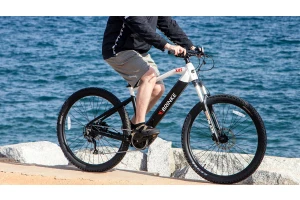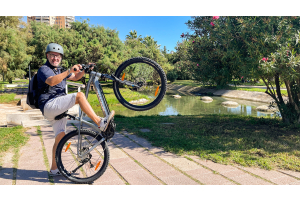August 29, 2024

How Beginners Can Learn Out-of-the-Saddle Sprinting
The image of cyclists desperately sprinting out of the saddle in the final stages of a race is always exhilarating. The French describe this as "dancing on the bike," with the rider and bicycle moving rhythmically side to side, creating a captivating and dynamic spectacle. Mastering out-of-the-saddle sprinting is something beginners often envy. However, it requires skill and today we’ll discuss how to learn this technique.
Out-of-the-saddle sprinting mainly involves using body weight to increase pedaling power. Simply put, it means standing up while pedaling to boost your output in a short time. Besides the power generated from the hips and legs, it also engages the core and upper body, utilizing the strength of the entire body. This movement requires specific muscle groups, making it more suitable for intermediate riders looking to diversify their riding techniques and enhance muscle strength.
Benefits of Learning Out-of-the-Saddle Sprinting: Practicing this technique has multiple advantages. Prolonged seated riding can lead to stiff and sore shoulders. Out-of-the-saddle sprinting activates various muscle groups, enhances blood circulation, and loosens stiff muscles while reducing the load on the gluteal muscles.
Key Points for Out-of-the-Saddle Sprinting:
-
Center of Gravity: When standing, avoid shifting your center of gravity forward, as this can make the front wheel lose its agility. The correct approach is to keep your center of gravity above the saddle, with a relaxed and flexible upper body.
-
Gear Ratio: Choosing the correct gear ratio is crucial. On flat terrain, increase the gear by 1-2 notches when sprinting out of the saddle; for steep climbs, there’s no need to change gears.
-
Posture: Avoid moving only your body and not the bike. This not only consumes a lot of energy but also disperses effort. The correct technique involves maintaining a stable core and allowing the bike to sway side to side, assisting your pedaling motions.
-
Gradual Progress: When practicing, focus first on mastering the fundamentals before gradually increasing your cadence. Side-to-side bike movement can lead to instability in the handlebars. Practice at a lower speed and higher gear ratio (i.e., low cadence) initially.
When Is Out-of-the-Saddle Sprinting Appropriate?
-
Climbing: Climbing requires higher power output, and out-of-the-saddle sprinting engages the entire body to achieve greater power, balancing the load on the thighs and glutes.
-
Attacking or Sprinting: In the final seconds of a race, out-of-the-saddle sprinting allows you to unleash all your strength and maximize power output for a strong finish.
-
Relaxation: During long seated rides, standing up and sprinting out of the saddle can help alleviate numbness in the lower body and provide relaxation.


 Deutsch
Deutsch  Español
Español  Deutsch
Deutsch 



Validate your login